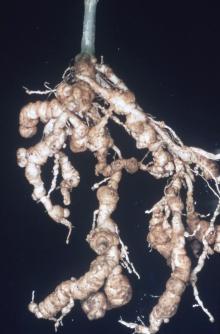See:
Tomato Varietal Resistance
Cause Meloidogyne hapla, a sedentary endoparasite. Only second-stage juveniles (the infective stage) and adult males (which may be rare) are in soil. Root-knot nematodes are found nearly everywhere and are the only known nematode pest of Oregon vegetables grown in the greenhouse. The nematodes usually are introduced with infested soil or mulch materials and in transplants.
Symptoms Infected plants are stunted and produce little or no fruit. They wilt conspicuously in warm weather. Knots or galls of infected roots are usually much larger and more numerous on greenhouse-grown crops than on field-grown crops.
Sampling Before planting, take soil samples with sufficient lead time to implement management procedures if necessary. For example, after soil fumigation, it may be several weeks before crops can be planted. Fall sampling for crops to be planted the following spring is an excellent strategy. When sending samples for diagnosis, include roots as well as soil.
Cultural control
- Plant resistant varieties.
- Use nematode-free plants to prevent introducing nematodes.
- Grow seedlings in nematode-free soil.
Chemical control Fumigate soil before planting.
- Salibro at 30.7 to 61.4 fl oz/A as a pre-plant soil incorporation and pre-plant/at-planting drip or at 15.4 to 30.7 fl oz/A as an in-season drip chemigation. Can be applied up to 4 times on a minimum of a 14-day interval. Preharvest interval is 1 day. 12-hr reentry.
- Telone II at 52 to 106 fl oz/1,000 ft of row using a single chisel on mineral soil. Wait 2 to 3 weeks after applying to plant, or until odor leaves the soil. Do not treat extremely heavy soils. 5-day reentry. Restricted-use pesticide.
- Vapam HL at 37.5 to 75 gal/A. See label for guidelines on rate, application conditions and methods. 48-hr reentry. Restricted-use pesticide
Biological control
- MeloCon WG for nematode suppression. See label for specific application types and timings. 4-hr reentry. O


